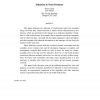Free Online Productivity Tools
i2Speak
i2Symbol
i2OCR
iTex2Img
iWeb2Print
iWeb2Shot
i2Type
iPdf2Split
iPdf2Merge
i2Bopomofo
i2Arabic
i2Style
i2Image
i2PDF
iLatex2Rtf
Sci2ools
ECML
1987
Springer
1987
Springer
Induction in Noisy Domains
This paper examines the induction of classification rules from examples using real-world data. Real-world data is almost always characterized by two features, which are important for the design of an induction algorithm. Firstly, there is often noise present, for example, due to imperfect measuring equipment used to collect the data. Secondly the description language is often incomplete, such that examples with identical descriptions in the language will not always be members of the same class. Many induction systems make the `noiseless domain' assumption that the examples do not contain errors and the description language is complete, and consequently constrain their search for rules to those for which no counterexamples exist in the data used for induction. However, in real-world domains correlations between attributes and classes in a data set are rarely without exceptions. To locate such correlations and induce rules describing them it is also necessary to consider rules whic...
Related Content
| Added | 28 Aug 2010 |
| Updated | 28 Aug 2010 |
| Type | Conference |
| Year | 1987 |
| Where | ECML |
| Authors | Peter Clark, Tim Niblett |
Comments (0)

